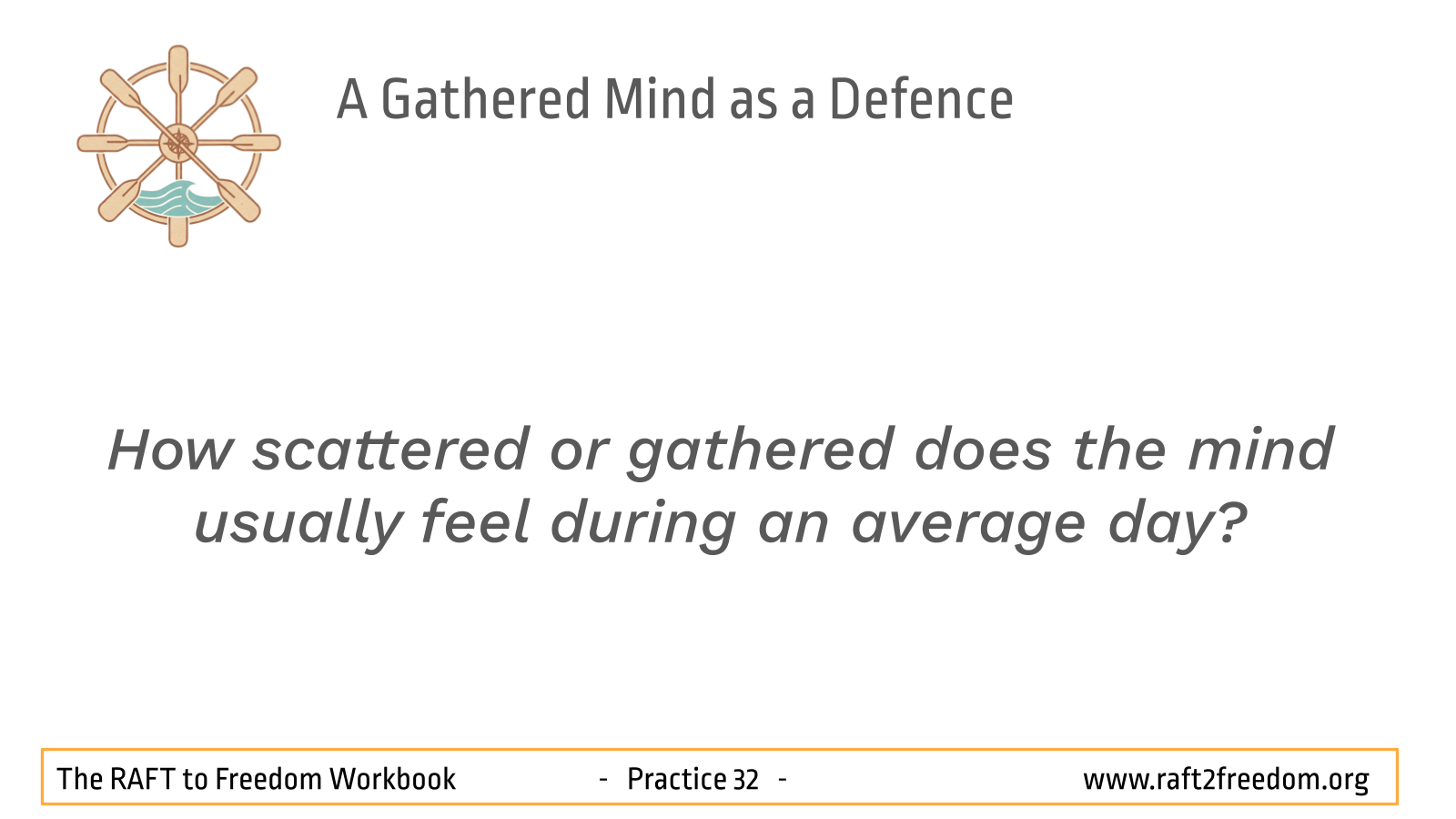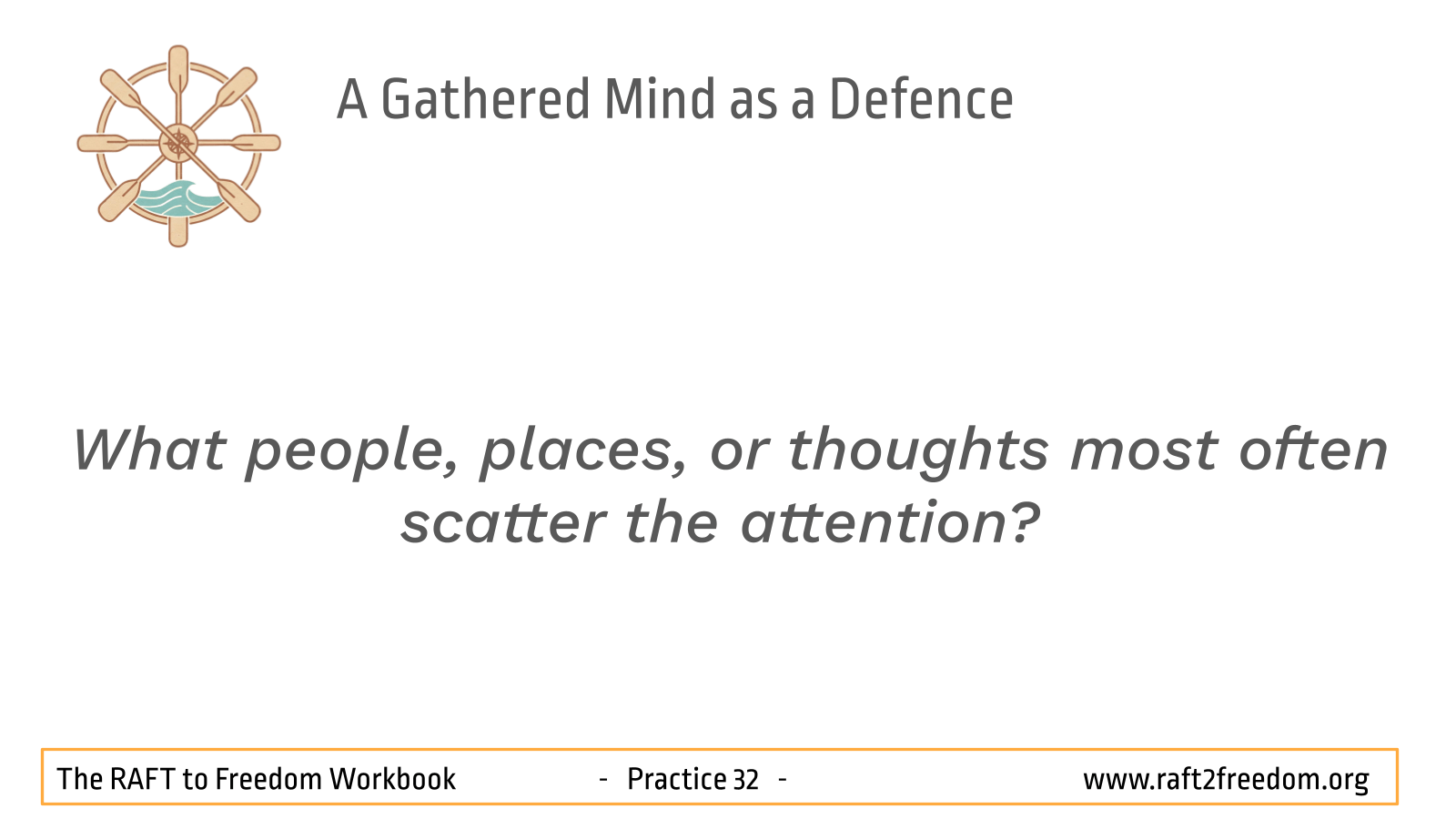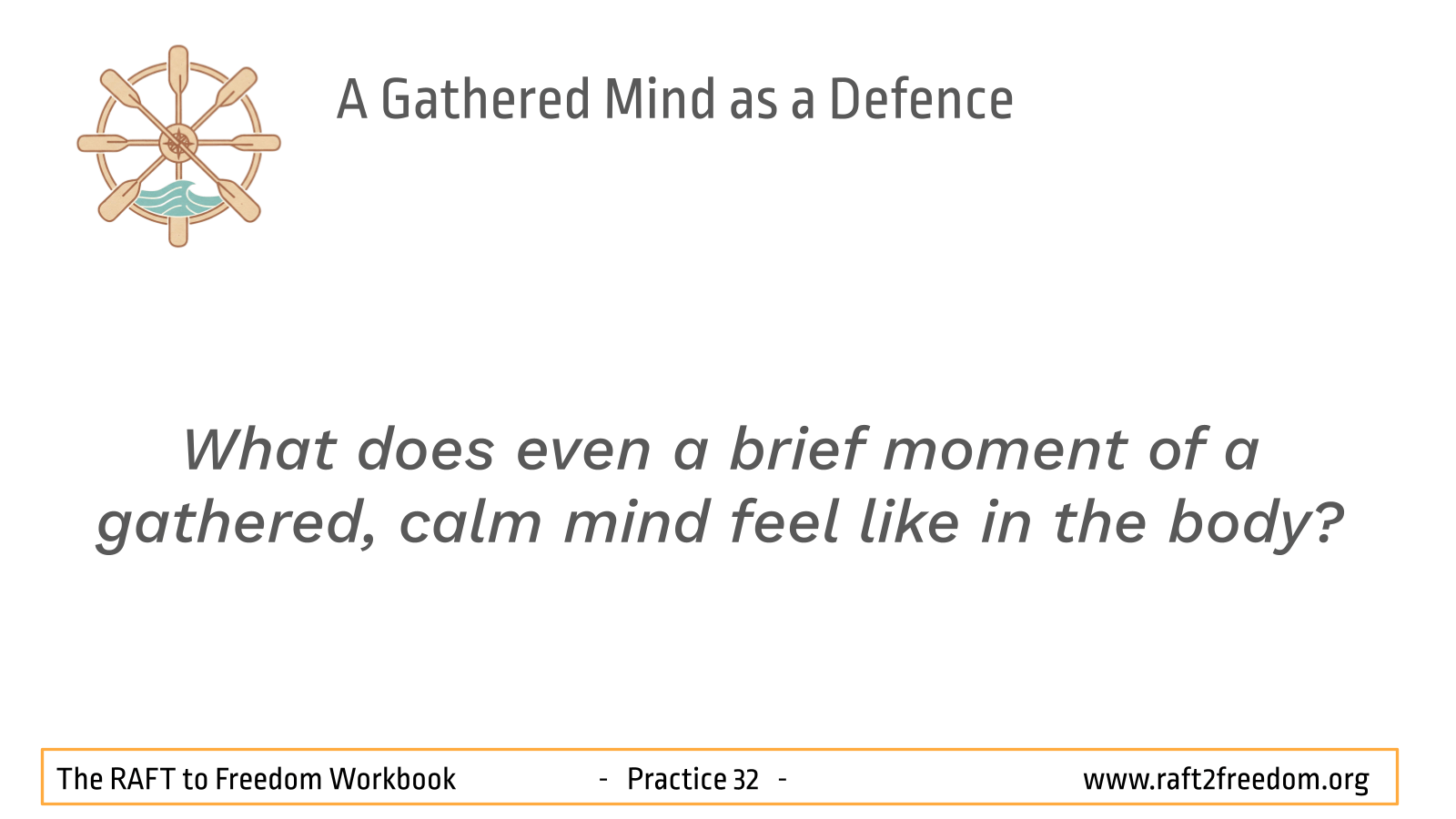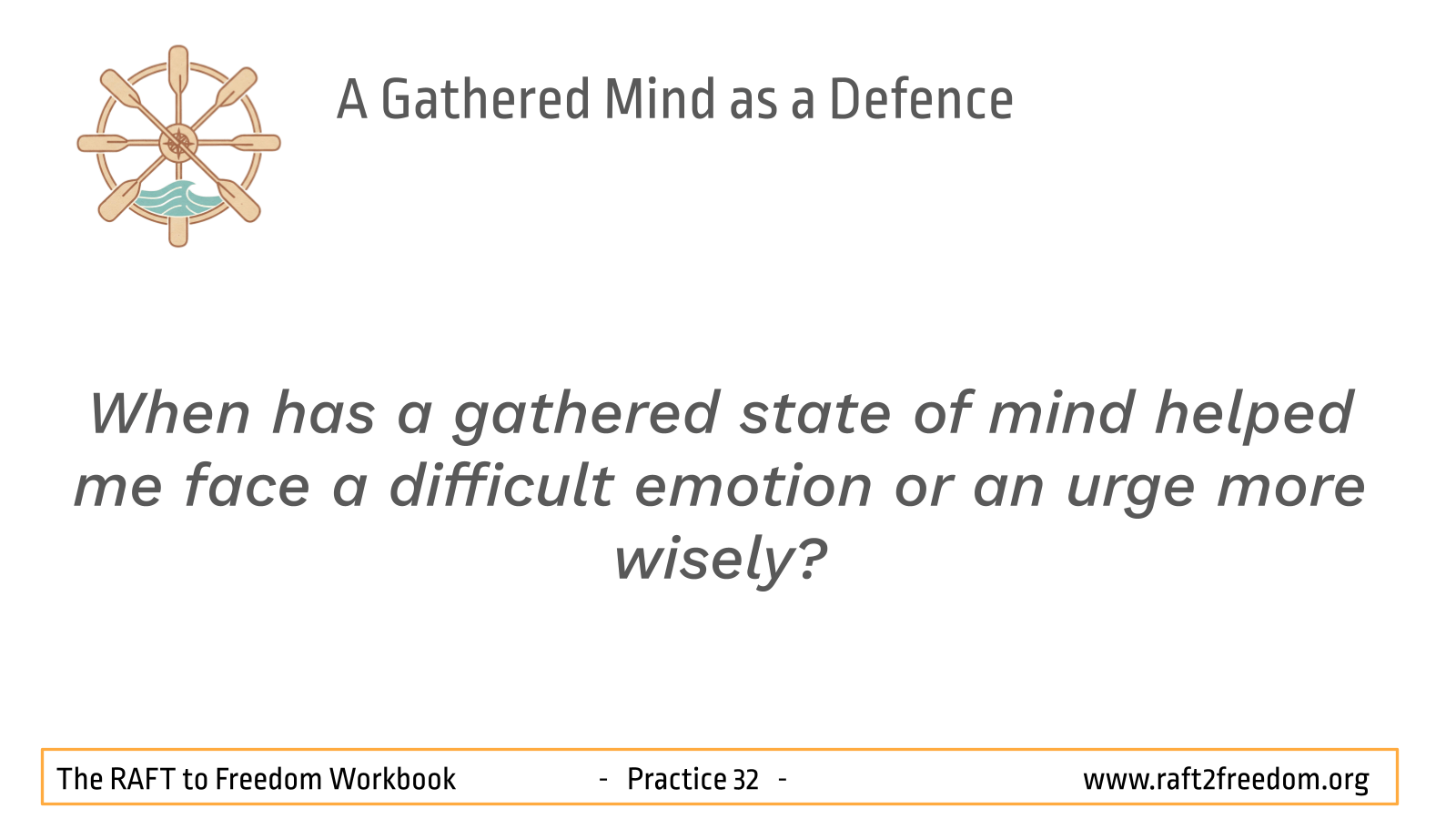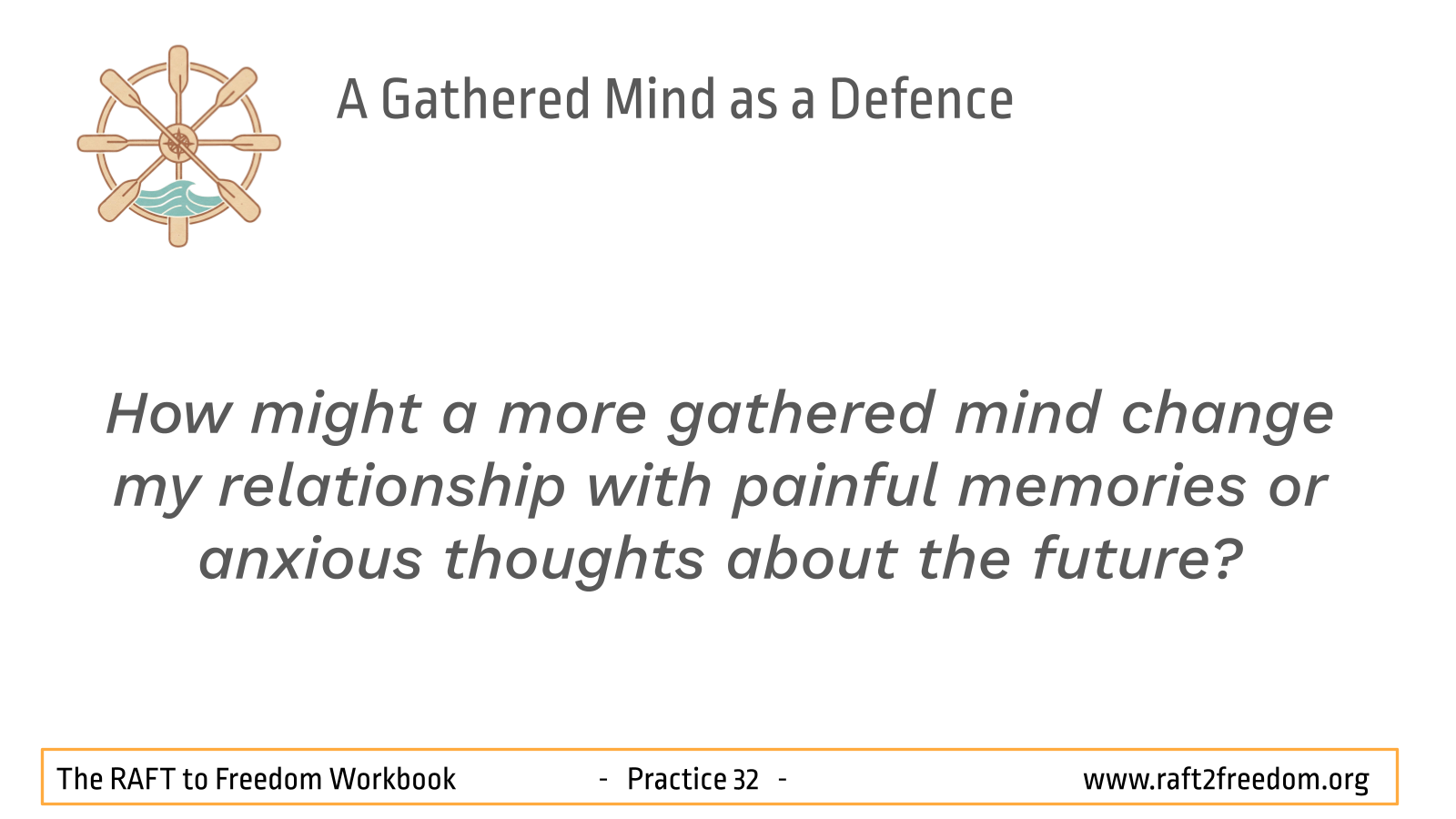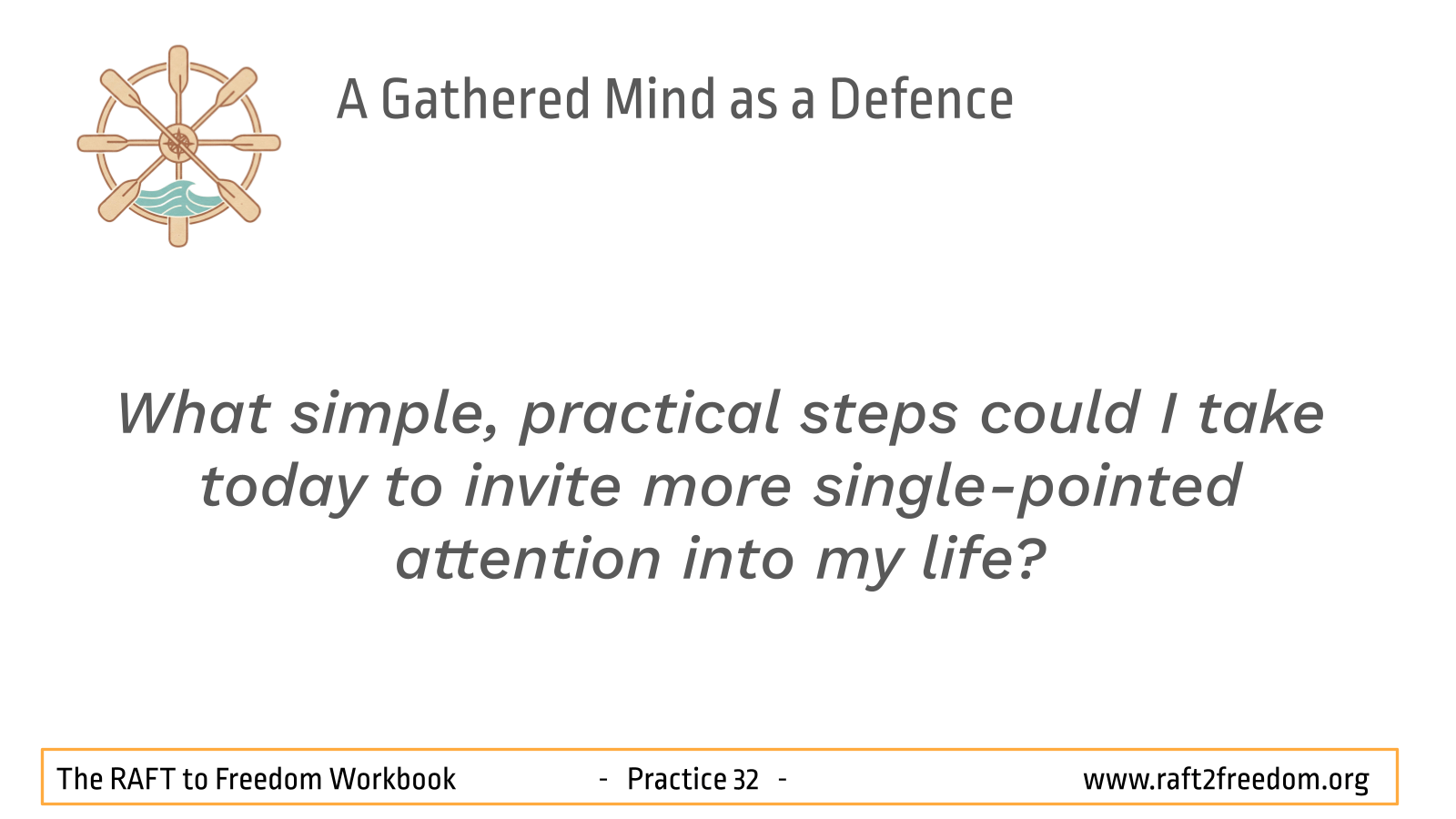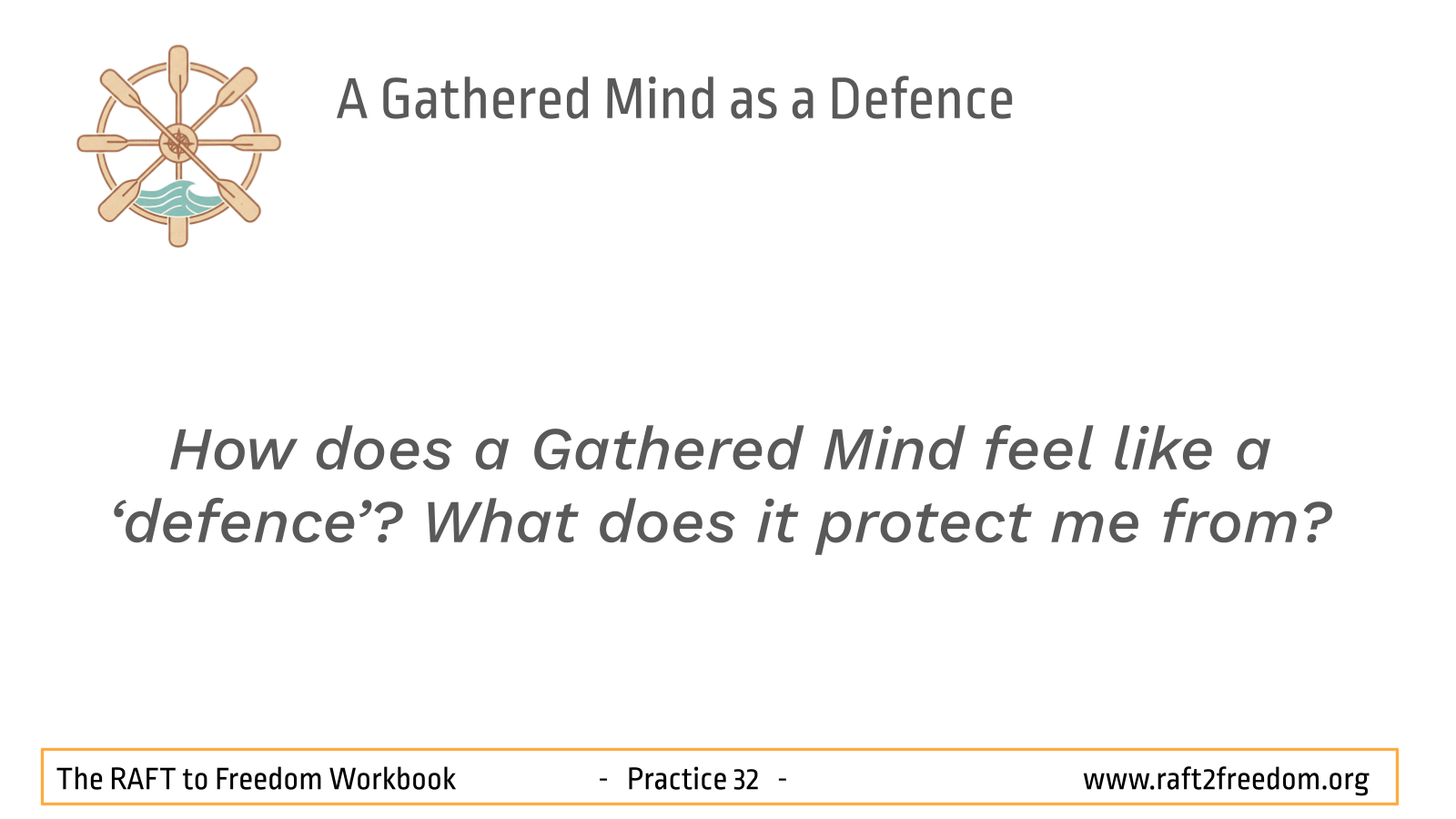Chapter 32: A Gathered Mind as a defence
The steady defender
We cannot see clearly because we are agitated, and we are agitated because we cannot see clearly.
Richard Gombrich
In zazen, leave your front door and your back door open. Let thoughts come and go. Just don’t serve them tea.
Shunryu Suzuki

Episode 32: A Gathered Mind as a defence
An AI generated ‘deep dive’ into this aspect of the RAFT to Recovery
Gathering the scattered mind
We now arrive at the fourth of our Five Defenders on the journey to freedom – ‘A Gathered Mind’, known in Pāli as samādhi. This Defender builds directly upon the foundation laid by ‘Healing Mindfulness’. While mindfulness is the faculty of noticing what arises in our experience, a Gathered Mind is the capacity to gather and sustain that awareness, bringing stability and clarity to the mind.
The word samādhi literally means ‘placing or bringing together,’ referring to the unification of the mind. It is the direct antidote to the scattered, restless, or agitated state – sometimes called washing machine head – that is intimately familiar to those struggling with harmful compulsions. If Healing Mindfulness is the lookout on our raft, A Gathered Mind is the keel and ballast, preventing it from capsizing and steadying its course in turbulent waters.
A mind lacking this quality is easily hijacked. A fleeting thought, an external trigger, or a wave of anxiety can send it spiraling into obsessive thinking or a compulsive act. Developing a Gathered Mind provides the steadfastness needed to observe these internal storms without being swept away, allowing us to see cravings and aversions clearly without having to obey them.
The four dimensions of a Gathered Mind in the 37 liberating practices
Gotama consistently placed a Gathered Mind at the heart of the path, where it appears four times across the 37 liberating practices, his core curriculum for attaining freedom. These repeated appearances are not redundant; they illustrate the progressive development of concentration from a raw potential into a profound, refined state of mind.
Concentration – the gathering power
- The developmental path: from Faculty to Power
- Faculty of concentration
Concentration first appears as the ability to recognise distraction and gently bring the mind back to its chosen focus. Its role is to control and actively overcome mental wandering, helping us stay present despite competing thoughts and impulses. At this stage, it is a developing faculty – a potential we all have that must be carefully balanced with energy. Too much force brings restlessness; too little, dullness. Through mindful practice, this faculty strengthens gradually, much like training an unsteady muscle to hold its balance. - Power of concentration
Through sustained and consistent practice, which we introduced in chapter 7, this fragile faculty matures into an intrinsic and reliable Defender. As steadiness deepens, concentration becomes unshakeable – impervious to distraction and scattering. It shifts from a consciously applied skill to an inner strength that holds firm amid craving, uncertainty, or emotional turbulence. This power provides the raft with its steady keel – the strength to remain upright and stable even when the waters of experience become rough. Here it is mature – a dependable embodied resilience of mind and heart.
- Faculty of concentration
- The tactical path: a support for freedom
When refined, concentration functions as a Support for freedom (bojjhaṅga), a specific medicine within the Seven Supports that belong to the calming group. Its role is to settle agitation and restlessness whenever they arise. In practice, it acts like a cooling balm applied precisely where the mind overheats with worry, craving, or irritation. Cultivated intentionally, it brings balance and clarity to moments of reactivity, allowing awareness to self-regulate in real time. At this stage, a Gathered Mind becomes responsive – a living quality of presence that restores inner equilibrium and steadies insight. We explore the Seven Supports in more detail within the third stage of our journey (chapter 43 onwards).
- The culminating path: ‘Appropriate Concentration’
Fully matured, concentration culminates in Appropriate Concentration (sammā-samādhi) – the final factor of the ‘Middleway’ – mental discipline. This is defined as the attainment of deep meditative absorptions where the five hindrances (chapters 37 – 42) are absent. In these profound states, the mind is unified, still, and radiant – perfectly balanced between alertness and ease. This stillness forms a platform from which intuitive wisdom can arise naturally. At this level, concentration is profound – the highest expression of mental unification. We will be exploring the Middleway in the final stage of our journey (Chapter 57 onwards) .
In the stillness of a gathered mind, wisdom arises naturally.
Gotama (The Buddha)
How to cultivate a Gathered Mind
We cultivate a Gathered Mind primarily through formal practice, allowing it to move from a fragile faculty to an unshakeable Defender.
- Mindfulness of breathing: Gently focus your attention on the physical sensation of the breath. When the mind wanders, kindly acknowledge the distraction and return your focus. This is the foundational practice for building a Gathered Mind. (Chapter 8)
- Loving-Kindness meditation: Use phrases of kindness toward yourself and others as the sustained object of focus. This not only builds concentration but also nurtures the heart. (Chapter 26)
- Practise single-tasking: Intentionally resist multitasking. When eating, just eat; when listening, just listen. Bring your undivided attention to the task at hand to strengthen your focus in daily life.
- Notice calm as well as craving: Pay attention to moments when the mind is naturally not reactive. Briefly dwell there. Recognising calm reinforces the possibility of Freedom – the ‘F’ in our RAFT metaphor – and makes it a familiar refuge.
- Check the mind’s tone: Occasionally pause during the day to ask: “How gathered is the mind right now?” This simple inquiry increases the awareness of scattering and serves as an invitation to return to steadiness.
Self-reflections
- How scattered or gathered does the mind usually feel during an average day?
- What people, places, or thoughts most often scatter the attention?
- What does even a brief moment of a gathered, calm mind feel like in the body?
- When has a gathered state of mind helped me face a difficult emotion or an urge more wisely?
- How might a more gathered mind change my relationship with painful memories or anxious thoughts about the future?
- What simple, practical steps could I take today to invite more single-pointed attention into my life?
- How does a Gathered Mind feel like a ‘defence’? What does it protect me from?
Journaling prompts
- Tracking the scatter: For one day, make a note of when the mind feels most scattered. What were the triggers? What did it feel like? What helped you return to a more gathered state?
- The joy of calm: Reflect on a time, however brief, when the mind felt naturally calm and at ease. Describe the inner and outer conditions that supported it. How can you invite more of those conditions into your life?
- The keel of the raft: Describe a recent situation where you felt emotionally turbulent. How might a more Gathered Mind (the keel and ballast) have helped you navigate it with more stability?
- An experiment in single-tasking: Choose one daily activity you usually do with distraction (like drinking coffee while checking your phone). For one week, commit to doing it with your full, undivided attention. Journal about what you notice.
- From faculty to defender: Write about the ways in which your concentration feels fragile (a faculty). What specific, small actions could you take to nurture it into a more reliable embodied strength (a Defender)?
- A dialogue with the ‘washing machine’: When the mind feels like a washing machine, write down the repetitive thoughts that are spinning. Then, write a compassionate response to them, acknowledging them without getting caught up in their spin.
- The feeling of focus: Sit for five minutes with the sole intention of keeping the mind on the breath. Afterward, journal about the experience. Was it difficult? Peaceful? Frustrating? What did you learn about the mind’s habits?
Supporting material: scientific and philosophical perspectives
For those interested in the scientific and philosophical underpinnings of a Gathered Mind as a Defence, the following overview highlights some key connections.
- Neuroscience: Concentration practices strengthen the brain’s attentional networks, particularly in the prefrontal cortex, enhancing the ability to sustain focus and resist distractions. This training reduces activity in the Default Mode Network (DMN), the brain region responsible for mind-wandering, rumination, and self-referential thinking, which is often overactive in addiction and anxiety. A Gathered Mind also improves emotion regulation by strengthening the connection between the prefrontal cortex and the amygdala, calming the brain’s fear centre and promoting a parasympathetic (rest-and-digest) response.
- Psychology: A Gathered Mind directly counters rumination – the repetitive thought loops that fuel anxiety and depression. By creating mental space, it allows you to see urges and cravings as temporary events rather than urgent commands. This aligns with the work of psychologist Mihaly Csikszentmihalyi on ‘flow states,’ which shows that deep, focused attention is inherently rewarding and fosters a sense of meaning and joy. Furthermore, a lack of concentration is a key feature of ADHD, a condition that frequently co-occurs with substance use disorders; training attention can therefore be a critical support for recovery.
- Philosophy: Many contemplative traditions affirm that a concentrated mind is the prerequisite for insight. Just as muddy water must be still to become clear, the mind must be gathered to perceive reality without distortion. Stoicism, for example, taught the ‘discipline of attention’ as fundamental to a virtuous life, emphasising the need to focus only on what is within our control – our thoughts and responses. This ancient wisdom echoes the Buddhist understanding that a Gathered Mind is the foundation upon which true freedom is built.
Remember to remember
A Gathered Mind is the ballast of our raft. It does not stop the waves of life from rising, but it gives us a steady place from which to navigate them. Each time we return to the breath, each time we anchor in the present moment, we are training the mind to gather itself.
Remember that this is not about forcing rigid stillness but about allowing the natural turbulence of the mind to settle. In the quiet space that emerges, joy and ease naturally arise. This calm clarity is itself a taste of freedom, a powerful reminder that peace is not somewhere else but can be found right here, in each moment of cultivated steadiness. When the mind is gathered, the other Defenders flourish: Confidence grows, Courageous Effort becomes sustainable, Healing Mindfulness becomes penetrating, and Discernment shines clearly.
The practice is not about perfect stillness but about learning to rest in motion.
Christina Feldman
Concentration is the art of returning—again and again—to what matters most.
Joseph Goldstein
Sutta references
- Ānāpānasati Sutta (MN 118) – Mindfulness of Breathing
- Summary: This is the foundational discourse on using the breath to cultivate the Four Foundations of Mindfulness and the Seven Factors of Awakening. It provides sixteen steps that guide the practitioner from basic awareness of the breath to deep states of concentration (samādhi) and liberating insight.
- Samādhi Sutta (AN 4.41) – Concentration
- Summary: The Buddha describes four developments of concentration: one that leads to a pleasant abiding in the here-and-now (the jhānas); one that leads to knowledge and vision; one that leads to mindfulness and alertness; and one that leads to the ending of the mental effluents (the taints). This shows that samādhi is a versatile tool for both stabilizing the mind and liberating it.
- Indriya-vibhaṅga Sutta (SN 48.10) – Analysis of the Faculties
- Summary: This sutta defines the five spiritual faculties, explaining the Faculty of Concentration (samādhi-indriya) as the mental stability achieved by making relinquishment one’s object, culminating in the four jhānas. It frames concentration as a developing “controlling” capacity.
| RAFT to Freedom © 2025 by Dr Cathryn Jacob and Vince Cullen is licensed under Creative CommonsAttribution-NonCommercial-ShareAlike 4.0 International. |

